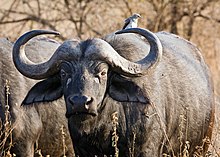Cape buffalo
| African buffalo Temporal range: 0.7–0 Ma -Holocene |
|
|---|---|
 |
|
| An African buffalo at Ngorongoro Conservation Area, Tanzania. | |
| Scientific classification | |
| Kingdom: | Animalia |
| Phylum: | Chordata |
| Clade: | Synapsida |
| Class: | Mammalia |
| Order: | Artiodactyla |
| Family: | Bovidae |
| Subfamily: | Bovinae |
| Genus: |
Syncerus Hodgson, 1847 |
| Species: | S. caffer |
| Binomial name | |
|
Syncerus caffer (Sparrman, 1779) |
|
| Subspecies | |
|
S. c. caffer |
|
S. c. caffer
S. c. nanus
S. c. brachyceros
S. c. aequinoctialis
S. c. mathewsi
The African buffalo or Cape buffalo (Syncerus caffer) is a large African bovine. It is not closely related to the slightly larger wild water buffalo of Asia and its ancestry remains unclear. Syncerus caffer caffer, the Cape buffalo, is the typical subspecies, and the largest one, found in South and East Africa. S. c. nanus (African forest buffalo) is the smallest subspecies, common in forest areas of Central and West Africa, while S. c. brachyceros is in West Africa and S. c. aequinoctialis is in the savannas of Central Africa. The adult buffalo's horns are its characteristic feature; they have fused bases, forming a continuous bone shield referred to as a "boss". They are widely regarded as very dangerous animals, as they gore and kill over 200 people every year.
The African buffalo is not an ancestor of domestic cattle and is only distantly related to other larger bovines. Owing to its unpredictable nature, which makes it highly dangerous to humans, the African buffalo has never been domesticated, unlike its Asian counterpart, the water buffalo. Other than humans, African Cape buffaloes have few predators aside from lions, and are capable of defending themselves. Being a member of the big five game, the Cape buffalo is a sought-after trophy in hunting.
The African buffalo is a very robust species. Its shoulder height can range from 1.0 to 1.7 m (3.3 to 5.6 ft) and its head-and-body length can range from 1.7 to 3.4 m (5.6 to 11.2 ft). Compared with other large bovids, it has a long but stocky body (the body length can exceed the wild water buffalo, which is heavier and taller) and short but thickset legs, resulting in a relatively short standing height. The tail can range from 70 to 110 cm (28 to 43 in) long. Savannah-type buffaloes weigh 500 to 1,000 kg (1,100 to 2,200 lb), with males normally larger than females, reaching the upper weight range. In comparison, forest-type buffaloes, at 250 to 450 kg (600 to 1,000 lb), are only half that size. Its head is carried low; its top is located below the backline. The front hooves of the buffalo are wider than the rear, which is associated with the need to support the weight of the front part of the body, which is heavier and more powerful than the back.
...
Wikipedia

